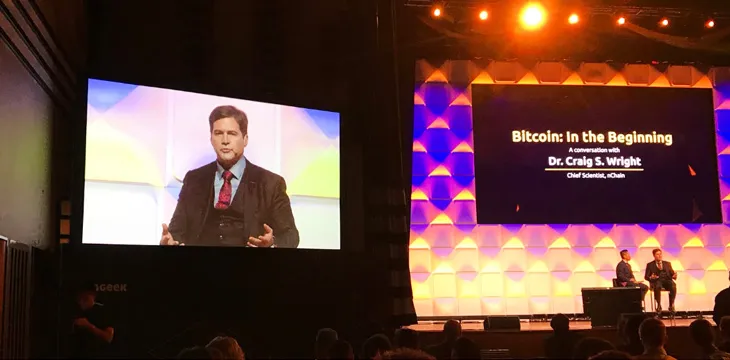|
Getting your Trinity Audio player ready...
|
You know you’ve been to a good conference when you leave with loads of interesting bits of information, combined with a better sense of the big picture. On both counts, CoinGeek Toronto was a resounding success. But it’s another measure that I’d say was even more important: there was a palpable feeling of confidence in the Bitcoin SV (BSV) ecosystem and where it’s heading.
At the last CoinGeek conference, in London in November, Jimmy Nguyen, president of the Bitcoin Association had stood on stage to say it was time for Bitcoin to “grow up and professionalise”. In Toronto, although he hadn’t entirely dropped his favourite mantra, he hardly needed it any more. The evidence was all around him.
To pick a couple of examples, almost at random: Cole Diamond, co-founder of CoinSquare, a Toronto startup, talked about using Bitcoin to bring the entire financial services industry onto one platform. The peer to peer lending it enables will reduce the cost of borrowing and mortgages. In case there was any doubt, at the end of his presentation, Cole remarked that “everybody in this room is on the right track”.
Cole was just one of several speakers who talked about how the Bitcoin world and the financial establishment were going to be able to work together productively.
Then there were the finalists of the BSV Hackathon competition, who were equally confident about the future. Attila from TonicPow explained that a “Tonic” is a peer to peer online ad. Why not use blockchain technology to connect website owners directly with those who want to pay them to advertise on their site? And Hayden Donnelly’s Polyglot product is designed to help people use the Metanet more easily. His aim is “to open up the Metanet for entry-level developers and everyday people.” (You’ll know he’s succeeded when Microsoft’s spell check stops putting a red line underneath every time you write “Metanet”.)
The Hackathon winner was UptimeSV, whose Dean Little explained plans for his BSV-based security product to prevent DDoS (distributed denial of service) attacks. He warned that as IoT (Internet of things) devices become more common, websites face an increasing danger of being attacked by “an army of smart fridges”.
If the Hackathon finalists were the up and coming generation, established BSV entrepreneurs like Jack Liu, Alex Agut and Rafael Seibane from HandCash and Ryan X. Charles of Moneybutton weren’t resting on their laurels. Jack’s new RelayX is integrating BSV and fiat payment platforms, Handcash is looking at ways to offer “Bitcoin as a service” and Moneybutton is powering ahead with new products such as Paymail, with a staff of only three: Ryan in Silicon Valley, with two colleagues in Argentina.
So much for the present and the future – what about the past? Well that was amply covered in Jimmy Nguyen’s interview with Dr. Craig Wright. It was a revealing and sometimes emotional session, going back to the origins of Bitcoin and Craig’s work as Satoshi Nakamoto, its pseudonymous creator. Craig said he’d started thinking about electronic money as far back as the 1990s, with an early idea for a paid network that he freely admits was “a failed, totally stupid concept”.
The work that led to the Bitcoin White Paper began in earnest around 2005 when he was studying at Newcastle University in New South Wales. On the question of whether he worked alone or had help, Craig replied that “everyone has help”. He mentioned Hal Finney and Dave Kleiman (“my best friend for a long time”) but to Jimmy’s direct “did you write the White Paper?” Craig answered definitively: “yes”.
“Who managed Satoshi’s email box?,” Jimmy enquired. “Primarily me,” Craig said. And it was “generally me” who answered posts on message boards, although it was occasionally Dave Kleiman.
On the first day that Bitcoin was released, it was managed on 69 computers, Craig said, some in his house, and some on a farm, a three hour drive away. When Microsoft decided to update its software in that first week, it messed up the whole Bitcoin system and Craig had to make numerous three hour drives between the house and the farm to sort things out.
Craig ended with a moving tribute to his wife and family for putting up with him, which more than one person told me afterwards had left them in tears. “I’m better than I was,” he said, but “I’ll never be nice.”
Craig’s final message was one which felt appropriate to end the whole conference. Despite the complex and technical nature of Bitcoin, Craig is clear that the point of it is to allow people to deal with people. This is not a technology that is designed to take over and dominate our lives: “I don’t want a world where we have people isolated by machines”.
It was an ambition that many of the entrepreneurs who’d spoken earlier had echoed in practical terms: we need to work to get the technology out of people’s way; the goal is to make the world and our transactions with each other, simpler, more accountable and frictionless. Craig thanked everyone for what they were doing in taking forward what he’d started. The audience rose to give him warm, appreciative thanks – both for the openness of his interview with Jimmy and, it felt, for Bitcoin itself.
https://www.youtube.com/watch?v=gBb9FSxfyVs

 09-16-2025
09-16-2025 





